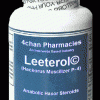I'm not sure if the person who originally dug up this study wants the credit and therefore blame if things somehow go wrong .. So I'll keep that anonymous for now and just remove their editing. My hope is that after further digging and discussion as to the safety and efficacy of the P21 peptide, members here could open a new thread for a custom synthesis group buy. Here we go:
Neurotrophic peptides incorporating adamantane improve learning and memory, promote neurogenesis and synaptic plasticity in mice, Bin Li, FEBS Letters Volume 584, Issue 15, 4 August 2010, Pages 3359-3365
Abstract
Development of neurotrophic peptidergic drugs that can mimic neurotrophins and promote neurogenesis and maturation of newborn cells into mature functional neurons represents an exciting therapeutic opportunity for treatment of Alzheimer disease and other learning and memory disorders as well as enhancing cognition of normal individuals. Here we report the design of a peptidergic compound, Ac-DGGLAG-NH2, called P21, when administered peripherally, enhanced learning as well as both short-term and spatial reference memories of normal adult C57Bl6 mice. P21 induced enhancement of neurogenesis and maturation of newly born neurons in the granular cell layer and subgranular zone of the dentate gyrus.
1. Introduction
As life expectancy in industrialized countries has been increasing by two years per decade in the last 20 years and is predicted to further surge, age-associated dementias like Alzheimer disease (AD) are becoming more and more heavy medical, economic, and social burden in modern society. AD affects over five million in the US and over twenty million worldwide. AD is the most prevalent dementia, followed by vascular dementia and dementia with Lewy bodies. AD has an average progression of 7–10 years, and is both multifactorial and heterogeneous. Despite AD being a severe public health problem, no neuroprotective and specific treatment is yet available. Numerous targets for pharmacological therapies of AD are currently under investigation [1].
To maintain or even restore cognitive health and memory is the ultimate goal in the treatment of dementia. Cerebrolysin (EBEWE Pharma, Unterach, Austria), a preparation of peptides and amino acids produced by standardized enzymatic digestion of porcine brain protein, has been shown to improve memory in patients with mild to moderate cognitive impairment [2] and [3]. This drug has also been shown to display neurotrophic activity in vitro [4] and [5] and in animal models of neurodegeneration [6] and [7]. Cerebrolysin enhances dentate gyrus (DG) neurogenesis in normal adult rats [8] and an APP transgenic model of AD [9].
The neurogenic effect of Cerebrolysin might be based upon the action of peptides in the preparation that are proteolytic products of neurotrophic factors. In a previous study, we found that Cerebrolysin contains peptides which react with neutralizing antibodies to human CNTF, GDNF, IGF-1 and IGF-2. More specifically, the CNTF neutralizing antibody can inhibit the neurogenic effects of Cerebrolysin [5]. Based on epitope mapping of neutralizing antibodies to human CNTF, we found that an 11-mer peptide; Peptide 6 (Ac-VGDGGLFEKKL-NH2) and a subsequence of it, Peptide 6c (Ac-DGGL-NH2), enhanced hippocampus-dependent learning and memory, increased neurogenesis and neuronal plasticity in normal adult mice [10] and [11].
Although peptides in general are readily bioavailable, systemic degradation through proteases and relatively poor blood–brain-barrier (BBB) permeability pose challenges in rendering peptides “druggable”. To address these design goals, we added adamantane building blocks to the C-terminus or both C- and N-termini of Peptide 6c. These bulky, highly lipophilic tricyclic alkane building blocks can increase the BBB permeability of peptides and block enzymatic degradation through exopeptidases. In the present study, we show that when administered peripherally to normal adult mice, the pentamer Ac-DGGLAG-NH2, called P21, significantly enhanced cognition, increased proliferation and neuronal differentiation of adult hippocampal progenitors and promoted the expression of synaptic vesicle proteins, synaptophysin and synapsin I.
2. Materials and methods
Fig. 1 shows the design and structures of peptidergic compounds employed in this study. For synthesis of peptidergic compounds incorporating adamantane building blocks, compounds P21(Ac-DGGLAG-NH2) and P22 (1-Ad-CO-DGGLAG-NH2), animals and housing, one trial object recognition test, spatial reference memory task in the water maze, immunohistochemistry, cell counts by stereology, analysis of the mechanism of action of P21 through LIF receptor in HepG2 cells, and statistical analysis, see Supplementary data.
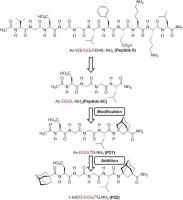
Fig. 1.
Design and structures of neurogenic peptidergic compounds incorporating adamantane building blocks. From the neurogenic undecamer Ac-VGDGGLFEKKL-NH2 (Peptide 6) a truncated, still neurogenic tetramer Ac-DGGL-NH2 (Peptide 6c) was designed. Addition of an unnatural amino acid based upon adamantane to the C-terminus of this subsequence via solid phase peptide synthesis methods produced Ac-DGGLAG-NH2 (P21); capping of the N-terminus of P21 with adamantane-1-carboxylic acid yielded 1-AdCO-DGGLAG-NH2 (P22).
3. Results
3.1. Effect of peptides incorporating adamantane on cognitive function in normal adult mice
3.1.1. General behavioral observations
Administration of the full-length CNTF protein in human clinical trials is known to cause anorexia, skeletal muscle loss, hyperalgesia, cramps, and muscle pain [12] and [13]. However, in the present study, we did not observe any alteration in either general physical state, body weight (Fig. 2A), exploratory behavior (Fig. 2C) or swim speed (Fig. 2D) during the period of the study, suggesting that treatment with compound P21 or P22 did not induce any apparent side-effects. In the water maze task, we did not observe any floating behavior suggesting that animals treated with P21 or P22 did not present any sign of depression or locomotor impairment. The only general behavioral characteristic P21 and P22 altered was the level of anxiety of the mice. As shown in Fig. 2B, mice treated with P21 or P22 spent more time in the center of the open field than control animals (P < 0.010, Student t-test) suggesting lower levels of anxiety.
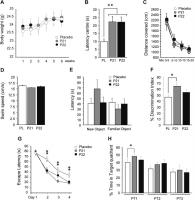
Fig. 2.
Peptides incorporating AGly improve cognition. P21 and P22 did not induce any effect on body weight (A), exploratory activity © or swim speed (D) but reduced anxiety level of mice (B). (E–F) P21 significantly improved the ability to discriminate a new object versus a familiar object. *P < 0.05; Student t-test. (G) P21 and P22 increased performance in the learning of spatial memory task in water maze. **P < 0.001; two-way ANOVA with post hoc Fisher LSD test. (H) P21 improved performance in the first probe trial (PT1), but treatment with P21 showed no effect 15 days (PT2) or 30 days (PT3) after the end of the treatment. *P < 0.05; Student t-test.
3.1.2. One-trial object recognition task
To examine short-term memory, we conducted a one-trial object recognition task. Mice treated with P21 clearly spent more time exploring the new object than the familiar object whereas other groups did not (Fig. 2E). The percentage of discrimination for animals treated with P21 was significantly increased compared to other groups (P < 0.05, Student t-test; Fig. 2F).
3.1.3. Spatial reference memory task
To investigate potential effects of P21 and P22 on hippocampal dependent memory, we conducted a spatial reference memory task in the water maze. Animals from all groups learned well, as evident by significantly declining escape latencies across training sessions (P < 0.05, two-way ANOVAs; Fig. 2G). However, performance of mice treated with P21 or P22 improved significantly faster than placebo-treated animals. Escape latencies to reach the submerged platform were significantly reduced for groups treated with P21 or P22 compared to control group from training day 2–4 (P < 0.01, two-way ANOVA and post hoc Fisher LSD test).
To evaluate the accuracy and the strength of the platform coordinates encoding, we performed probe trials and measured the time animals spent looking for the platform in the target quadrant. We first carried out a probe trial 24 h after the last day of training. Then, to evaluate remote memory, we performed probe trials 15 and 30 days after the training and the end of the chronic treatment. Analysis of retention of memory in the three probe trials confirmed that all animals had correctly encoded the platform location during training since they spent more than 25% of the trial period looking for it in the target quadrant (Fig. 2H). During the first probe trial, animals treated with P21 focused significantly more on the target quadrant compared to control animals (P < 0.05, Student t-test). However, this beneficial effect disappeared on day 15 and day 30 washout periods after the end of the treatment with the peptide. No statistically significant effect of P22 was observed in the probe trials.
Overall, results from the object recognition task and the spatial reference memory task show that P21 induced positive effects on cognition.
3.1.4. Enhancement of neurogenesis in the DG
Because neurogenesis is thought to have an important role in memory and associated learning [14], [15] and [16], we investigated potential changes induced by chronic treatment with P21 and P22.
Quantitative evaluation of neurogenesis in the DG revealed a significant increase of BrdU positive cells in the granule cell layer (GCL) and subgranular zone (SGZ) of animals treated with P21 (P < 0.05, two-way ANOVA and post hoc Fisher LSD test; Fig. 3A and B). No significant alteration in neurogenesis was observed in the group treated with P22 (Fig. 3A and B).
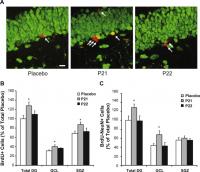
Fig. 3.
Compound P21 promotes neurogenesis in the DG. (A) Representative picture of double labeled BrdU (red) and NeuN (green) positive cells. Scale bar represents 20 μm. (B) Numbers of BrdU positive cells were significantly increased in P21 treated animals in the total DG, GCL and in the SGZ © P21 treatment significantly increased the number of BrdU/NeuN positive cells in the GCL and in the total DG. *P < 0.05, two- way ANOVA and post hoc Fisher LSD test.
To estimate net neurogenesis, we next examined the expression of the marker for mature neurons, NeuN, in the BrdU positive cells in the DG. A significant increase of the number of BrdU/NeuN positive cells was observed in the DG of mice treated with P21 due to a significant increase in BrdU/NeuN positive cells in the GCL (P < 0.05, two-way ANOVA and post hoc Fisher LSD test; Fig. 3A and C). No significant changes were observed in the group of animals treated with P22.
3.1.5. Enhancement of synaptic plasticity
Synapses are critical components of the neural mechanisms underlying learning and memory. In order to investigate whether P21 and P22 have neurotrophic effects, we measured the expression of two synaptic vesicle proteins; synaptophysin and synapsin I.
Significant increases of synaptophysin and synapsin I immunoreactivities were observed in the GCL and molecular cell layer (MCL) of animals treated with P21 (P < 0.001, two-way ANOVA and post hoc Fisher LSD test; Fig. 4A and B). Animals treated with P22 expressed similar levels of immunoreactivity of synaptophysin and synapsin I as did untreated control animals.
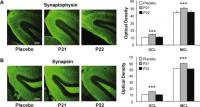
Fig. 4.
Compound P21 promotes synaptic plasticity in the DG. P21 significantly promoted expression of synaptophysin (A) and synapsin I (B) in the GCL and the MCL of the DG. ***P < 0.001, two-way ANOVA and post hoc Fisher LSD test. Scale bars represent 100 μm.
3.1.6. Antagonistic effect of P21 on LIF signaling
To investigate whether P21 affects LIF signaling pathway, we treated HepG2 cells with different concentrations of P21 from 0.01 to 1000 nM along with 0.25 nM LIF for 15 min, and then measured STAT3 phosphorylation by Western blots. We observed that LIF-induced STAT3 phosphorylation was inhibited slightly in a dose-dependent manner. In HepG2 cells, 10 nM of P21 inhibited 30% of LIF-induced phosphorylation of STAT3 (P < 0.005, Student t-test; Fig. 5).
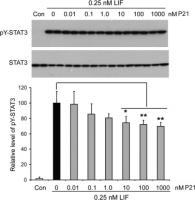
Fig. 5.
Inhibition of LIF-induced STAT3 phosphorylation by P21 in a dose-dependent manner in HepG2 cells. HepG2 cells were treated with different concentrations of P21 together with 0.25 nM LIF for 15 min, and then the STAT3 phosphorylation at Tyr705 (pY-STAT3) was determined by Western blots. The pY-STAT3 value was normalized to total STAT3 expression. Data are presented as percentages of the value from cells treated with 0.25 nM LIF alone (100%). *P < 0.05; **P < 0.01.
4. Discussion
Neurotrophic factors are critical for neuronal differentiation, maturation, and survival, but in the AD brain, the balance of neurotrophic factors is disturbed. Level of basic fibroblast growth factor is upregulated, whereas the levels of brain-derived neurotrophic factor and neurotrophin 4 are reduced in the hippocampus, the frontal cortex and the parietal cortex (for review, see [17]. Because they are crucial to maintain a healthy neuronal microenvironment, neurotrophins generated excitement over the past decades as therapeutic targets for AD and other dementias. However, inconvenient pharmacokinetics and adverse side-effect profiles have limited clinical utilization of neurotrophic factors [18]. Therefore, chemically modified short peptides able to mimic positive characteristics of neurotrophic factors represent an opportunity to circumvent these obstacles.
Derivatives of the diamondoid C10H16 hydrocarbon adamantane have already been commercialized as antivirals (amantadine, rimantadine) and as central nervous system active drugs. Nowadays, the aminoadamantane Memantine® is the only drug prescribed for moderate to severe cases of AD. Based on the physicochemical and pharmacological properties of drugs incorporating the adamantane motif, an adamantane-based moiety has been used as a drug carrier for poorly absorbed compounds, including peptides, active towards the central nervous system [19] and [20]. In a previous study, we demonstrated the beneficial effect of a CNTF-based tetrapeptide, Peptide 6c, on hippocampus-dependent memory in normal adult mice [11]. We hypothesized that adding lipophilic groups to Peptide 6c could increase its biostability and BBB permeability and consequently enhance its neurotrophic, neuroplastic, and cognitive enhancement activities. We attached the rigid, bulky, and highly lipophilic, unnatural 3-aminoadamantane-1-carboxylic acid (“AGly”) C-terminally to the Peptide 6c to produce compound P21. The rigidity of the -amino acid AGly should block the carboxypeptidase activity, thereby stabilizing Peptide 6c in vivo [21]. Enhancing the overall lipophilicity of Peptide 6c should boost its ability to cross the BBB. By capping the N-terminus of the sequence of Peptide 6c with adamantane-1-carboxylic acid in P22, we speculated that it would further increase lipophilicity and BBB penetration as well as resistance against aminopeptidase activity.
In AD, the hippocampus is the most vulnerable brain region to neurodegeneration [22]. Moreover, hippocampus-dependent cognitive impairments are associated with synaptic loss [23] which occurs early in the development of AD [24]. Reduction of synaptophysin in the hippocampus correlates with cognitive decline in AD patients [25] and with decreased synaptic activity in several mouse models of AD [26] and [27]. Therefore, in the present study we investigated effects of compounds P21 and P22 on hippocampus-dependent cognitive functions and on hippocampal synaptic plasticity.
In the present study, P21 significantly enhanced two different cognitive mechanisms;
-> an object recognition task and
-> a spatial reference memory task.
The one-trial object recognition task is thought to critically depend on the entorhinal cortex, hippocampus and frontal cortex [28], [29], [30] and [31]. In the present study we observed that control animals as well as animals treated with P22 did not preferentially explore the novel object. This null preference did not reflect a lack of interest for novelty but rather enhanced attraction for familiarity [32]. This reveals that, for control and P22-treated animals, familiar object representation is yet to be built and finalized, therefore requiring as much attention as the novel object to complete the encoding. On the contrary, animals treated with P21 displayed a marked preference for the novel object. This suggests that the representation of the familiar object has been fully encoded, and then was not anymore a subject of attention at the expense of the novel stimulus. These results showed that P21 treatment accelerated the encoding of object representation, thus, in the present experimental condition, improved short-term memory performance.
In the spatial reference memory task, the hippocampal system processes information about the relationships among distal environmental cues into a spatial map where spatial coordinates of the submerged platform are encoded [33]. The hippocampus is also crucial for memory storage, consolidation and restitution of the spatial information [34]. In the present study, we observed that both P21 and P22 increased the learning of the task suggesting that both peptides strengthened processing of the spatial environment. However, only P21 positively enhanced performances in the probe trial. This shows that the beneficial effect of P21 on encoding, storage, and consolidation of the spatial information during the treatment period is stronger than of P22.
Examining hippocampal synaptic activity, we next found that P21 induced significant increase in synaptophysin and synapsin I immunoreactivity in the DG. Synaptophysin is a glycoprotein of the presynaptic vesicles [35] involved in the vesicle trafficking machinery [36] by regulating synaptic vesicle exocytosis [37]. Besides, Synapsin I is a neuro-specific phosphoprotein highly concentrated in presynaptic nerve terminals, where, associated with the cytoplasmic surface of the synaptic vesicle, it plays a key role in neurotransmitter release [38]. We observed that P21 positively enhanced synaptophysin and synapsin I levels. This suggests that P21 had a beneficial effect on synaptic plasticity by increasing the presynaptic release of neurotransmitters. We speculate that this augmentation of neurotransmitters in the synaptic cleft potentiates post-synaptic excitability, subsequently enhancing the efficacy of the neuronal network taking charge of stimulus processing to encode, store or recall information.
The contribution of adult hippocampal neurogenesis to memory has been studied at experimental and theoretical levels. Current literature supports the idea that both neural stem cells and immature neurons play distinct roles in hippocampus-dependent memory tasks [39]. Newly born mature cells may have an inherent advantage of being recruited into patterns of new memory networks [40]. In the present work, we observed that P21 increased progenitor cell proliferation as well as neuronal differentiation. Thus, through this neurogenic activity, P21 enhanced the stock of functional neurons to be potentially recruited into neuronal networks of information processing. This characteristic of P21 might be crucial as a potential treatment for neurodegeneration since in AD, although proliferation of immature neurons is increased, newly generated neurons in the DG do not mature [41] and [42].
The present study shows that P21 induces neuronal plasticity and neurogenic properties which consequently enhance cognition. In particular, we have investigated the effects of P21 in the hippocampus, but, considering positive enhancement of the object recognition task which involves other brain structures as well as the hippocampus, we speculate that the beneficial effect of P21 we have shown to be connected with neuronal plasticity in the DG may occur in other brain areas as well.
In previous work we showed that Peptide 6 contains a putative leukemia inhibitory factor receptor-binding sequence of CNTF and interferes with the signal transduction of LIF more than with that of CNTF [10]. Because LIF inhibits neurogenesis in the DG [43], [44] and [45], we hypothesized that Peptide 6 enhances neurogenesis through the CNTF pathway, inducing a partial inhibition of LIF. The present study shows that P21 acts as its parent molecule, the 11-mer peptide, partially inhibiting LIF activity through the STAT3 pathway. Because we did not observe conclusive effects of the closely related derivative P22, which differs in the N-terminal acylation, on cognition, neuronal plasticity and neurogenesis, we assume that incorporating an additional adamantane moeity instead of the smaller N-acetyl group at the N-terminus of P21 to furnish P22, probably prevented a proper interaction of the active –DGGL– subsequence with its receptors.
Overall, in the present study we have shown that the CNTF-derived peptidergic compound, P21, incorporating a γ-aminoadamantane-1-carboxylic acid at its C-terminus, is neurogenic and neuroplastic and enhances cognition in normal adult mice. It is important to note that demonstrating positive effects of the studied peptides is a challenging task because it is difficult to observe enhancement of cognition due to ceiling effects in normal adult mice we have used previously. Although we previously observed beneficial effects of the CNTF tetra peptide, Peptide 6c, on memory [11], the improvements in object recognition and spatial reference memory we report here for the pentamer P21 are more pronounced. We thus conclude that the lipophillically modified, CNTF-derived pentamer P21 is an attractive candidate for the development of pro-cognitive drugs to prevent and treat learning and memory disorders and neurodegenerative diseases such as AD.
References
[1] K. Iqbal and I. Grundke-Iqbal, Developing pharmacological therapies for Alzheimer disease, Cell. Mol. Life Sci. 64 (2007), pp. 2234–2244. Full Text via CrossRef | View Record in Scopus | Cited By in Scopus (17)
[2] E. Ruther, R. Ritter, M. Apecechea, S. Freytag, R. Gmeinbauer and M. Windisch, Sustained improvements in patients with dementia of Alzheimer’s type (DAT) 6 months after termination of Cerebrolysin therapy, J. Neural. Transm. 107 (2000), pp. 815–829. View Record in Scopus | Cited By in Scopus (31)
[3] X.A. Alvarez et al., A 24-week, double-blind, placebo-controlled study of three dosages of Cerebrolysin in patients with mild to moderate Alzheimer’s disease, Eur. J. Neurol. 13 (2006), pp. 43–54. Full Text via CrossRef | View Record in Scopus | Cited By in Scopus (44)
[4] M. Mallory, W. Honer, L. Hsu, R. Johnson, E. Rockenstein and E. Masliah, In vitro synaptotrophic effects of Cerebrolysin in NT2N cells, Acta Neuropathol. 97 (1999), pp. 437–446. Full Text via CrossRef | View Record in Scopus | Cited By in Scopus (17)
[5] H. Chen, Y.C. Tung, B. Li, K. Iqbal and I. Grundke-Iqbal, Trophic factors counteract elevated FGF-2-induced inhibition of adult neurogenesis, Neurobiol. Aging 28 (2007), pp. 1148–1162. Article | PDF (3013 K) | View Record in Scopus | Cited By in Scopus (29)
[6] L. Francis-Turner and V. Valouskova, Nerve growth factor and nootropic drug Cerebrolysin but not fibroblast growth factor can reduce spatial memory impairment elicited by fimbria–fornix transection: short-term study, Neurosci. Lett. 202 (1996), pp. 193–196. Article | PDF (370 K) | View Record in Scopus | Cited By in Scopus (51)
[7] E. Masliah, F. Armasolo, I. Veinbergs, M. Mallory and W. Samuel, Cerebrolysin ameliorates performance deficits, and neuronal damage in apolipoprotein E-deficient mice, Pharmacol. Biochem. Behav. 62 (1999), pp. 239–245. Article | PDF (1824 K) | View Record in Scopus | Cited By in Scopus (51)
[8] Y. Tatebayashi, M.H. Lee, L. Li, K. Iqbal and I. Grundke-Iqbal, The dentate gyrus neurogenesis: a therapeutic target for Alzheimer’s disease, Acta Neuropathol. (Berl) 105 (2003), pp. 225–232. View Record in Scopus | Cited By in Scopus (48)
[9] E. Rockenstein, M. Mante, A. Adame, L. Crews, H. Moessler and E. Masliah, Effects of Cerebrolysin on neurogenesis in an APP transgenic model of Alzheimer’s disease, Acta Neuropathol. 113 (2007), pp. 265–275. Full Text via CrossRef | View Record in Scopus | Cited By in Scopus (23)
[10] Chohan, M.O., Li, B., Blanchard, J., Tung, Y.C., Heaney, A.T., Rabe, A., Iqbal, K. and Grundke-Iqbal, I. (2009). Enhancement of dentate gyrus neurogenesis, dendritic and synaptic plasticity and memory by a neurotrophic peptide. Neurobiol. Aging, Epub ahead of print, Sept. 2009.
[11] Blanchard, J., Chohan, M.O., Li, B., Liu, F., Iqbal, K. and Grundke-Iqbal, I. (2010). Beneficial effect of a CNTF tetrapeptide on adult hippocampal neurogenesis, neuronal plasticity and spatial memory in mice. J. Alzheimer’s Dis., in press.
[12] A.C.T. SG, A double-blind placebo-controlled clinical trial of subcutaneous recombinant human ciliary neurotrophic factor (rHCNTF) in amyotrophic lateral sclerosis. ALS CNTF Treatment Study Group, Neurology 46 (1996), pp. 1244–1249.
[13] M. Windisch, A. Gschanes and B. Hutter-Paier, Neurotrophic activities and therapeutic experience with a brain derived peptide preparation, J. Neural. Transm. Suppl. 53 (1998), pp. 289–298. View Record in Scopus | Cited By in Scopus (39)
[14] E. Gould, A. Beylin, P. Tanapat, A. Reeves and T.J. Shors, Learning enhances adult neurogenesis in the hippocampal formation, Nat. Neurosci. 2 (1999), pp. 260–265. Full Text via CrossRef | View Record in Scopus | Cited By in Scopus (1016)
[15] T.J. Shors, G. Miesegaes, A. Beylin, M. Zhao, T. Rydel and E. Gould, Neurogenesis in the adult is involved in the formation of trace memories, Nature 410 (2001), pp. 372–376. Full Text via CrossRef | View Record in Scopus | Cited By in Scopus (949)
[16] J.S. Snyder, N.S. Hong, R.J. McDonald and J.M. Wojtowicz, A role for adult neurogenesis in spatial long-term memory, Neuroscience 130 (2005), pp. 843–852. Article | PDF (485 K) | View Record in Scopus | Cited By in Scopus (252)
[17] K. Schindowski, A. Bretteville, K. Leroy, S. Begard, J.P. Brion, M. Hamdane and L. Buee, Alzheimer’s disease-like tau neuropathology leads to memory deficits and loss of functional synapses in a novel mutated tau transgenic mouse without any motor deficits, Am. J. Pathol. 169 (2006), pp. 599–616. Article | PDF (2547 K) | Full Text via CrossRef | View Record in Scopus | Cited By in Scopus (73)
[18] R.D. Price, S.A. Milne, J. Sharkey and N. Matsuoka, Advances in small molecules promoting neurotrophic function, Pharmacol. Ther. 115 (2007), pp. 292–306. Article | PDF (680 K) | View Record in Scopus | Cited By in Scopus (27)
[19] K. Kitagawa, N. Mizobuchi, T. Hama, T. Hibi, R. Konishi and S. Futaki, Synthesis and antinociceptive activity of [D-Ala2]Leu-enkephalin derivatives conjugated with the adamantane moiety, Chem. Pharm. Bull. (Tokyo) 45 (1997), pp. 1782–1787. View Record in Scopus | Cited By in Scopus (11)
[20] N. Tsuzuki, T. Hama, T. Hibi, R. Konishi, S. Futaki and K. Kitagawa, Adamantane as a brain-directed drug carrier for poorly absorbed drug: antinociceptive effects of [D-Ala2]Leu-enkephalin derivatives conjugated with the 1-adamantane moiety, Biochem. Pharmacol. 41 (1991), pp. R5–R8. Abstract | PDF (199 K) | View Record in Scopus | Cited By in Scopus (28)
[21] J. Frackenpohl, P.I. Arvidsson, J.V. Schreiber and D. Seebach, The outstanding biological stability of beta- and gamma-peptides toward proteolytic enzymes: an in vitro investigation with fifteen peptidases, ChemBioChem 2 (2001), pp. 445–455. Full Text via CrossRef | View Record in Scopus | Cited By in Scopus (203)
[22] B.T. Hyman, G.W. Van Hoesen, A.R. Damasio and C.L. Barnes, Alzheimer’s disease: cell-specific pathology isolates the hippocampal formation, Science 225 (1984), pp. 1168–1170. View Record in Scopus | Cited By in Scopus (675)
[23] R.D. Terry, E. Masliah, D.P. Salmon, N. Butters, R. DeTeresa, R. Hill, L.A. Hansen and R. Katzman, Physical basis of cognitive alterations in Alzheimer’s disease: synapse loss is the major correlate of cognitive impairment, Ann. Neurol. 30 (1991), pp. 572–580. Full Text via CrossRef | View Record in Scopus | Cited By in Scopus (1207)
[24] E. Masliah, W.G. Honer, M. Mallory, M. Voigt, P. Kushner, L. Hansen and R. Terry, Topographical distribution of synaptic-associated proteins in the neuritic plaques of Alzheimer’s disease hippocampus, Acta Neuropathol. 87 (1994), pp. 135–142. Full Text via CrossRef | View Record in Scopus | Cited By in Scopus (39)
[25] C.I. Sze, H. Bi, B.K. Kleinschmidt-DeMasters, C.M. Filley and L.J. Martin, Selective regional loss of exocytotic presynaptic vesicle proteins in Alzheimer’s disease brains, J. Neurol. Sci. 175 (2000), pp. 81–90. Article | PDF (883 K) | View Record in Scopus | Cited By in Scopus (57)
[26] A.Y. Hsia et al., Plaque-independent disruption of neural circuits in Alzheimer’s disease mouse models, Proc. Natl. Acad. Sci. USA 96 (1999), pp. 3228–3233. Full Text via CrossRef | View Record in Scopus | Cited By in Scopus (544)
[27] T.A. Lanz, D.B. Carter and K.M. Merchant, Dendritic spine loss in the hippocampus of young PDAPP and Tg2576 mice and its prevention by the ApoE2 genotype, Neurobiol. Dis. 13 (2003), pp. 246–253. Article | PDF (393 K) | View Record in Scopus | Cited By in Scopus (65)
[28] J.B. Mitchell and J. Laiacona, The medial frontal cortex and temporal memory: tests using spontaneous exploratory behaviour in the rat, Behav. Brain Res. 97 (1998), pp. 107–113. Article | PDF (198 K) | View Record in Scopus | Cited By in Scopus (58)
[29] A. Ennaceur and J.P. Aggleton, The effects of neurotoxic lesions of the perirhinal cortex combined to fornix transection on object recognition memory in the rat, Behav. Brain Res. 88 (1997), pp. 181–193. Article | PDF (450 K) | View Record in Scopus | Cited By in Scopus (112)
[30] A. Ennaceur, N. Neave and J.P. Aggleton, Spontaneous object recognition and object location memory in rats: the effects of lesions in the cingulate cortices, the medial prefrontal cortex, the cingulum bundle and the fornix, Exp. Brain Res. 113 (1997), pp. 509–519. Full Text via CrossRef | View Record in Scopus | Cited By in Scopus (210)
[31] R.E. Clark, S.M. Zola and L.R. Squire, Impaired recognition memory in rats after damage to the hippocampus, J. Neurosci. 20 (2000), pp. 8853–8860. View Record in Scopus | Cited By in Scopus (233)
[32] Ennaceur, A. (2010). One-trial objects recognition in rats and mice: methodological and theoritical issues. Behav. Brain Res., in press.
[33] R.G. Morris, P. Garrud, J.N. Rawlins and J. O’Keefe, Place navigation impaired in rats with hippocampal lesions, Nature 297 (1982), pp. 681–683. Full Text via CrossRef | View Record in Scopus | Cited By in Scopus (2453)
[34] G. Riedel et al., Reversible neural inactivation reveals hippocampal participation in several memory processes, Nat. Neurosci. 2 (1999), pp. 898–905. View Record in Scopus | Cited By in Scopus (247)
[35] R. Jahn, W. Schiebler, C. Ouimet and P. Greengard, A 38 000-dalton membrane protein (p38) present in synaptic vesicles, Proc. Natl. Acad. Sci. USA 82 (1985), pp. 4137–4141. Full Text via CrossRef | View Record in Scopus | Cited By in Scopus (328)
[36] R. Janz, T.C. Sudhof, R.E. Hammer, V. Unni, S.A. Siegelbaum and V.Y. Bolshakov, Essential roles in synaptic plasticity for synaptogyrin I and synaptophysin I, Neuron 24 (1999), pp. 687–700. Article | PDF (351 K) | View Record in Scopus | Cited By in Scopus (108)
[37] C.P. Arthur and M.H. Stowell, Structure of synaptophysin: a hexameric MARVEL-domain channel protein, Structure 15 (2007), pp. 707–714. Article | PDF (1220 K) | View Record in Scopus | Cited By in Scopus (7)
[38] P. Greengard, F. Valtorta, A.J. Czernik and F. Benfenati, Synaptic vesicle phosphoproteins and regulation of synaptic function, Science 259 (1993), pp. 780–785. View Record in Scopus | Cited By in Scopus (706)
[39] J.B. Aimone, J. Wiles and F.H. Gage, Potential role for adult neurogenesis in the encoding of time in new memories, Nat. Neurosci. 9 (2006), pp. 723–727. Full Text via CrossRef | View Record in Scopus | Cited By in Scopus (235)
[40] N. Kee, C.M. Teixeira, A.H. Wang and P.W. Frankland, Preferential incorporation of adult-generated granule cells into spatial memory networks in the dentate gyrus, Nat. Neurosci. 10 (2007), pp. 355–362. Full Text via CrossRef | View Record in Scopus | Cited By in Scopus (193)
[41] B. Li, H. Yamamori, Y. Tatebayashi, B. Shafit-Zagardo, H. Tanimukai, S. Chen, K. Iqbal and I. Grundke-Iqbal, Failure of neuronal maturation in Alzheimer disease dentate gyrus, J. Neuropathol. Exp. Neurol. 67 (2008), pp. 78–84. Full Text via CrossRef | View Record in Scopus | Cited By in Scopus (37)
[42] K. Jin, A.L. Peel, X.O. Mao, L. Xie, B.A. Cottrell, D.C. Henshall and D.A. Greenberg, Increased hippocampal neurogenesis in Alzheimer’s disease, Proc. Natl. Acad. Sci. USA 101 (2004), pp. 343–347. View Record in Scopus | Cited By in Scopus (341)
[43] T. Shimazaki, T. Shingo and S. Weiss, The ciliary neurotrophic factor/leukemia inhibitory factor/gp130 receptor complex operates in the maintenance of mammalian forebrain neural stem cells, J. Neurosci. 21 (2001), pp. 7642–7653. View Record in Scopus | Cited By in Scopus (159)
[44] M.A. Bonaguidi, T. McGuire, M. Hu, L. Kan, J. Samanta and J.A. Kessler, LIF and BMP signaling generate separate and discrete types of GFAP-expressing cells, Development 132 (2005), pp. 5503–5514. Full Text via CrossRef | View Record in Scopus | Cited By in Scopus (75)
[45] S. Bauer and P.H. Patterson, Leukemia inhibitory factor promotes neural stem cell self-renewal in the adult brain, J. Neurosci. 26 (2006), pp. 12089–12099. Full Text via CrossRef | View Record in Scopus | Cited By in Scopus (68)





































